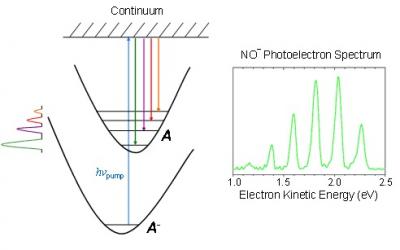Utilizing anion photoelectron spectroscopy, we are able to quickly determine the electron affinities and measure the vibrational frequencies of neutral molecules. In this technique, the electrons are ejected from a packet of mass-selected anions (A-) by intersecting it with the harmonics of a Nd:YAG laser (1064 nm, 532nm, or 355 nm) or by the output of a mid-infrared OPO/OPA laser. Since the energy of the laser excitation is constant, the kinetic energy of the ejected electrons is the difference between the pump energy (hυpump) and the energy of the neutrals levels (A).
or by the output of a mid-infrared OPO/OPA laser. Since the energy of the laser excitation is constant, the kinetic energy of the ejected electrons is the difference between the pump energy (hυpump) and the energy of the neutrals levels (A).
We measure the kinetic energy of the photoejected electron using velocity-map imaging (VMI). The photoelectrons are extracted perpendicular to the anion beam using three electrostatic lenses and accelerated toward a position-sensitive detector and the end of a short flight tube. When the photoelectrons hit the detector, they light up a spot on the phosphor screen which is captured by a CCD camera. The ones with greater kinetic energy appear at a larger radius relative to the center of the detector and we can thus reconstruct the photoelectron kinetic energy distribution. Because the laser energy is known, we can use this distribution to extract information about the quantum levels of the neutral molecules and the parent anion.  We have applied this technique as a useful structural diagnostic for anions with weakly bound excess electrons such as water clusters, solvated species and small organic molecules. This technique can also be adapted to a two-laser scheme which yields isomer-specific information or can be used to study photo-induced electron-transfer reactions.
We have applied this technique as a useful structural diagnostic for anions with weakly bound excess electrons such as water clusters, solvated species and small organic molecules. This technique can also be adapted to a two-laser scheme which yields isomer-specific information or can be used to study photo-induced electron-transfer reactions.
We enjoy showcasing our VMI technology to visitors as it gives one of the most striking visualizations of quantum mechanics in action.
1) Elliott, B. M.; McCunn, L. R.; Johnson, M. A. Photoelectron imaging study of vibrationally mediated electron autodetachment in the type I isomer of the water hexamer anion Chem. Phys. Lett. 467, 32 (2008).
2) Breen, K. J.; DeBlase, A. F.; Guasco, T. L.; Voora, V. K.; Jordan, K. D.; Nagata, T.; Johnson, M. A. Bottom-Up View of Water Network-Mediated CO2 Reduction Using Cryogenic Cluster Ion Spectroscopy and Direct Dynamics Simulations J. Phys. Chem. A 116, 903 (2012).
3) Gerardi, H. K.; DeBlase, A. F.; Leavitt, C. M.; Su, X.; Jordan, K. D.; McCoy, A. B.; Johnson, M. A. Structural characterization of electron-induced proton transfer in the formic acid dimer anion, (HCOOH)2−, with vibrational and photoelectron spectroscopies J. Chem. Phys. 136, 134318 (2012).
4) Eppink, A. T.; Parker, D. H.; Velocity map imaging of ions and electrons using electrostatic lenses: Application in photoelectron and photofragment ion imaging of molecular oxygen Rev. Sci. Instrum., 68, 3477 (1997).
5) Chandler, D. W.; Houston, P. L.; Two-dimensional imaging of state-selected photodissociation products detected by multiphoton ionization J. Chem. Phys., 87, 1445 (1987).
6) Sanov, A.; Mabbs, R.; Photoelectron imaging of negative ions Int. Rev. Phys. Chem., 27, 53 (2008).